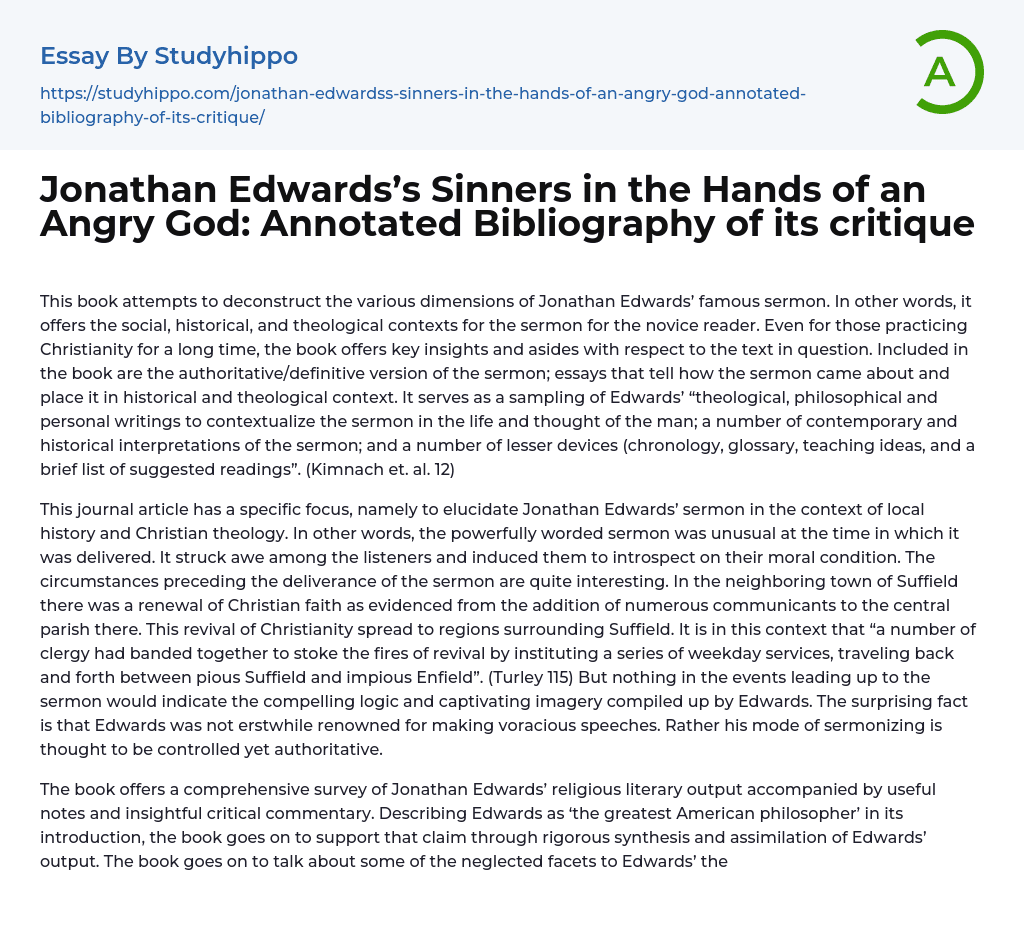

Heights: A Study of Jonathan Edwards’ Sermon Sinners in the Hands of an Angry God
This book attempts to deconstruct the various dimensions of Jonathan Edwards’ famous sermon. In other words, it offers the social, historical, and theological contexts for the sermon for the novice reader. Even for those practicing Christianity for a long time, the book offers key insights and asides with respect to the text in question. Included in the book are the authoritative/definitive version of the sermon; essays that tell how the sermon came about and place it in historical and theological context. It serves as a sampling of Edwards’ “theological, philosophical and personal writings to contextualize the sermon in the life and thought of the man; a number of contemporary and historical interpretations of the sermon; and a number of lesser devices (chronology, glossary, teaching ideas, and a brief list of suggested readings”. (Kimnach et. al. 12)
...This journal article has a specific focus, namely to elucidate Jonathan Edwards’ sermon in the context of local history and Christian theology. In other words, the powerfully worded sermon was unusual at the time in which it was delivered. It struck awe among the listeners and induced them to introspect on their moral condition. The circumstances preceding the deliverance of the sermon are quite interesting. In the neighboring town of Suffield there was a renewal of Christian faith as evidenced from the addition of numerous communicants to the central parish there. This revival of Christianity spread to regions surrounding Suffield. It is in this context that “a number of clergy had banded together to stoke the fires of revival by instituting a series of weekday services, traveling back and forth between pious Suffield and impious Enfield”. (Turley 115) But nothin
in the events leading up to the sermon would indicate the compelling logic and captivating imagery compiled up by Edwards. The surprising fact is that Edwards was not erstwhile renowned for making voracious speeches. Rather his mode of sermonizing is thought to be controlled yet authoritative.
The book offers a comprehensive survey of Jonathan Edwards’ religious literary output accompanied by useful notes and insightful critical commentary. Describing Edwards as ‘the greatest American philosopher’ in its introduction, the book goes on to support that claim through rigorous synthesis and assimilation of Edwards’ output. The book goes on to talk about some of the neglected facets to Edwards’ theological oeuvre. By adopting such an approach, the book critically re-appropriates his theology to the postmodern sensibility. For example, dimensions of Edwards’ output that garner attention include the influences of John Calvin, Francois Turretin and Petrus van Maastricht on the former. Also, the book explores Edwards’ Augustinianism in the backdrop of early Enlightenment thought. This is an interesting analytic angle, for the tone and style of the Sinners sermon goes against the grain of rationalism which is the essence of the Enlightenment. The endeavor of the compilers of this anthology is to offer scholarly perspectives that are different to the preceding works by Robert E. Brown and Gerald R. McDermott. The focus of the collection seems to be its juxtaposition of Christian dogma and the Enlightenment ethos.
What the book also manages to showcase Edwards’ theology as more refined than is what is commonly believed. For all the negative publicity the fundamentalist streak in the sermon garners, Edwards understood God in surprisingly contemporary terms. For example, he sought to “comprehend the
divine largely in terms of a relationship of love and of beauty that draws humanity to God.” (Lee 221) His conception of beauty, though, is a bit more conservative, in that, he measured it in terms of “proportion, symmetry, contrast, comparison, and by relations, an experience of beauty which he illustrated by discussing the harmonious and pleasurable music of a choir, natural phenomena such as color, and the relationships among the human senses.” (Lee 221)
This collection of key religious texts and speeches in the short history of American Christianity is similar to the compilation by Sang Hyun Lee. This book is a kind of secular liberal version of Jerry Falwell’s Listen America (1980), filled throughout with quotes from ‘The Founders’. But where it fails is the inadequacy to fulfill this goal. For example, the quotes are usually torn off from their contexts and are mostly incomplete. Of all the Founders covered by Meacham, Jonathan Edwards is just one figure.
- Cosmetics essays
- Skin care essays
- Makeup essays
- Baptism essays
- Holy Spirit essays
- Jesus Christ essays
- Adam And Eve essays
- Crucifixion Of Jesus essays
- Crusades essays
- Eucharist essays
- God The Father essays
- Pope essays
- Protestantism essays
- Christian essays
- Church essays
- Elizabeth essays
- Sacrament essays
- Catholic Church essays
- Lord essays
- Priest essays
- Protestant Reformation essays
- Spirituality essays
- Angel essays
- Adaptation essays
- Adventure essays
- Adversity essays
- Aging essays
- Alcohol essays
- Barbie Doll essays
- Beauty essays
- Care essays
- Carpe diem essays
- Change essays
- Chess essays
- Chicken essays
- Choices essays
- Contrast essays
- Crops essays
- Development essays
- Dream essays
- Evil essays
- Experience essays
- Family essays
- Farm essays
- Fire essays
- First Love essays
- Focus essays
- Greed essays
- Hero essays
- Holiday essays



